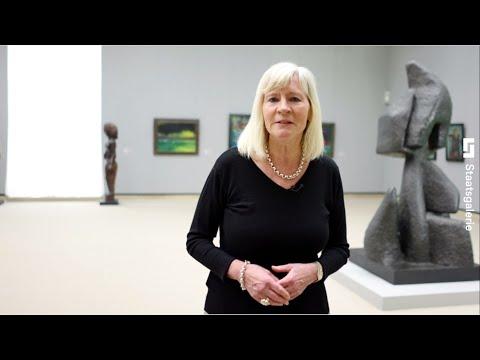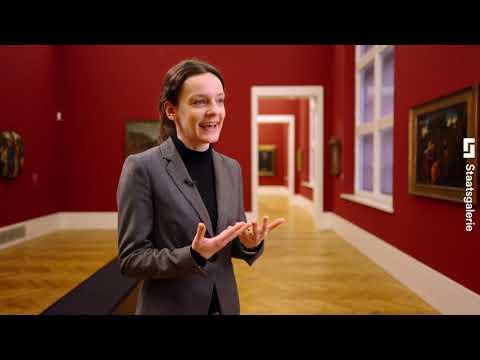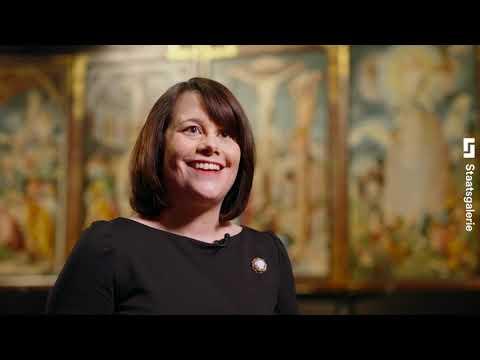Collection films
You can discover over 700 years of art history in our collection, including many masterpieces and an internationally outstanding collection on modern art. Works of the Old Masters from Ratgeb to Memling, Italian art from Tiepolo to Vasari, works of Classical Modernism such as Marc's Horses and Schlemmer's Triads, to contemporary works by Kienholz and Probst – our curators present these highlights to you in the new film series.
Contemporary Art
In the first film of our film series, Dr Alessandra Nappo presents our collection of contemporary art. It is currently on display under the title "Tense Conditions" and awaits the return of visitors. Until then, the film will give you a first insight.
3 questions to Dr. Alexandra Nappo
Which forms of expression are characteristic of the era?
"Compared to other art epochs, "contemporary art" is characterised by a great variety of forms of expression. Since the 1960s, performance, happening and Fluxus have established themselves as forms of action art. These are ephemeral forms in which the body of the artist becomes the central component of the work. In the 1960s and 1970s, artists experimented with photographic techniques, partly as a reaction to abstract painting and at a time when action was highly charged. Another media expansion of this period was the emergence of videos, for which Nam June Paik is considered a pioneer. In the course of time, artistic forms have become so mixed that today it is sometimes difficult to define which medium an artist works with: They are often multimedia works or expansive installations that include sculpture, video, photography and other media."
Are there themes that are typical of the art period?
"Not only the art forms, but also the themes since the 1960s are characterised by a great diversity. However, one can recognise a socially critical perspective as a common thread. Several artistic positions since the 1960s and 1970s, such as Edward Kienholz, Yoko Ono, Jürgen Klauke or Katharina Sieverding - to name just a few in the collection - deal with socially explosive topics that still concern us today: social injustice, racism, violence, exclusion, sexual identity, exploitation of nature."
Which is your favourite work?
"As I have been intensively involved with the new collection presentation "Tense States" over the last few months, I would mention one work exhibited in this presentation: the "Torsione" (Turning) by Giovanni Anselmo. The date of origin of the sculpture (1968) makes it an incunabulum of Italian "Arte Povera". In the work, tension is captured in the material: The webs of flannel fabric attached to the wall with a ring were twisted by the force of several people until they no longer allowed any further twisting. The energy expended is stored in the object and can literally be felt. We can thus sense how much effort and joint force is needed to fundamentally change a condition. At any moment, however, the fabric could unwind and the tension discharged."
Classical modernism
In this film, Dr Ina Conzen presents our internationally renowned collection of classical modernism with works by Picasso, Gris, Marc and Schlemmer, among others.
3 questions to Dr. Ina Conzen
Are there themes that are typical of the art period?
"Classical Modernism" in the visual arts refers to those avant-garde styles that emerged towards the end of the 19th century and broke with the norms of traditional academic art and teaching. They had precursors, such as the Impressionists or Gauguin, and emerged in rapid succession, often in parallel. Artists like Edvard Munch or Ernst Ludwig Kirchner wrote "unadulterated expression" on their banners. And of course, their psychologically charged language of colour and form was initially much criticised; it was perceived as sketchy and crude, thus unprofessional."
Which forms of expression are characteristic of the era?
"For many artists, most poignantly for Egon Schiele, the human body becomes a reflection of the soul. Others, such as Picasso and the Cubists, dissected the object in a much more rational, yet no less revolutionary way. In the 1920s, socially critical themes came to the fore, especially in Germany, while at the Bauhaus, a reformed "new construction of the future" was sought by bringing together art and production. In addition, there are the magically charged visual worlds of the Surrealists and, especially during the war, Picasso's stirring works. The art of this epoch is immensely complex – and after the Second World War it was then a matter of proving that art was still possible at all after the global horror. There were exciting abstract currents in many countries, against which more "democratic" positions, i.e. positions close to the everyday world, were formed again at the end of the 1950s with Pop Art, Happening, Fluxus."
Which is your favourite work?
"I don't have a favourite work in that sense, there are too many."
Italian painting
In this film, curator Dr Christine Seidel takes you on a tour of our collection of Italian paintings, including Vasari's Toilet of Venus, a major work from Florence, and Tiepolo, Venice's finest painter.
3 questions to Dr. Christine Seidel
Are there themes that are typical of the art period?
"A major theme of Italian art is religion, which is related to the context in which many works were created. Besides that, there is a whole field of new themes that are only developing, like something like portraiture, the representation of man in his time. Another big theme is the representation of historical or mythological stories, which always plays with the concrete and the fantastic, the real and the imaginable, and in this it also crosses borders."
Which forms of expression are characteristic of the era?
"Emotion! Regardless of the subject matter, the impressive thing is that art which at first appears mimetic creates the illusion of reality at second glance through colour, line and form, which captivates us."
Which is your favourite work?
"Around 108 paintings are presented in the collection, about 30 more temporarily as part of the Baroque Gallery in Ludwigsburg. It is always fascinating to see how diverse the collection is and how one's own view of it is constantly changing. I particularly like Luca Giordano's self-portrait, fascinating how a view can still be so vivid over 300 years later."
Early German and Dutch Art
In this film, curator Dr Sandra-Kristin Diefenthaler shows you the works of the Old Masters in our collection of Early German and Dutch Art, such as Bathsheba in the Bath and the Herrenberg Altar.
3 questions to Dr. Sandra-Kristin Diefenthaler
Are there themes that are typical of the art period?
"In the area of ""Early German Painting"", religious themes are predominant, as altars from the pre-Reformation period form the focus of the collection here. Landscapes, still lifes and portraits are then mainly represented in the area of "Dutch Painting" from around 1600 onwards, so that we can show all genres of painting."
Which forms of expression are characteristic of the era?
"Consistently characteristic of the "Early German and Netherlandish Painting" department are the multitude of hidden symbols that the viewer has to decipher – plants, animals and colours have a deeper meaning and are not randomly placed in the picture, but underline the pictorial content of the altarpieces, still lifes and portraits."
Which is your favourite work?
"When people ask me about my favourite works in the collection, I feel like a traitor. So first of all: there is no work that I don't like. Nevertheless, there are works that are among my highlights for various reasons, I'll reveal four: Hans Memling's "Bathsheba im Bade", Christoph Amberger's "Georg Hörmann", Hans von Aachen's "Allegorie" and David de Heem's "Stillleben mit Nautiluspokal."


